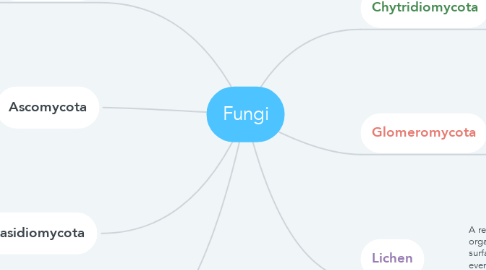Fungi
by Andrew Suazo

1. Zygomycota
1.1. Up to 1,000 known species. Includes fast growing molds that grow on some of our favorite fruit. The reason it does this is to absorb nutrients from our favorite foods much like we do. A sturdy structure called zygosporangium is also produced.
2. Ascomycota
2.1. Lives in marine, freshwater, and terrestrial habitats. Known for its production of spores in saclike asci. So they can be called sac fungi. Fruiting bodies are also produced which make them very unique. Reproduction is asexual through spores called conidia.
3. Basidiomycota
3.1. These include mushrooms, puffballs, and shell fungi. They are very important for decomposing the complex polymer lignin. When trees are weak and vulnerable these fungi move in to feast on them. They reproduce sexually by producing fruit bodies called basidiocarps.
4. Andrew Suazo Bio 2
5. Chytridiomycota
5.1. Are Ubiquitous in lakes and soil. Possible to find in hydrothermal vented areas as well as marine communities. Some tend to be decomposers while others are in the parasite classification. They are very important mutualists that can even live within the body of animals to break down matter. Zoospores are what make them unique and it is here where we are able to find out the certain keys that set them apart from the others.
6. Glomeromycota
6.1. Once thought to be zygomycetes, but now seen in a new clade. Not as much info is known but they are arbuscular mycorrhizae. They very tips of the hyphae push into the plant. Mutualistic partnerships are also common among them.
7. Lichen
7.1. A relationship between a photosynthetic organism and a fungus. These grow on the surface of rocks, rotting logs, trees, and even roofs. Asexual reproduction is common and the formation of soredia is also a process.


